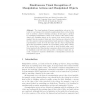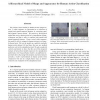185 search results - page 20 / 37 » Human action recognition using the motion of interest points |
PR
2007
13 years 7 months ago
2007
In this paper, we shall address the issue of semantic extraction of different regions of interest. The proposed approach is based on statistical methods and models inspired from l...
ICANN
2005
Springer
14 years 1 months ago
2005
Springer
Humans can recognize biological motion from strongly impoverished stimuli, like point-light displays. Although the neural mechanism underlying this robust perceptual process have n...
CVPR
2010
IEEE
14 years 3 months ago
2010
IEEE
A central problem in the analysis of motion capture (Mo-
Cap) data is how to decompose motion sequences into primitives.
Ideally, a description in terms of primitives should
fac...
ECCV
2008
Springer
14 years 9 months ago
2008
Springer
Abstract. The visual analysis of human manipulation actions is of interest for e.g. human-robot interaction applications where a robot learns how to perform a task by watching a hu...
CVPR
2007
IEEE
14 years 9 months ago
2007
IEEE
We present a novel model for human action categorization. A video sequence is represented as a collection of spatial and spatial-temporal features by extracting static and dynamic...


